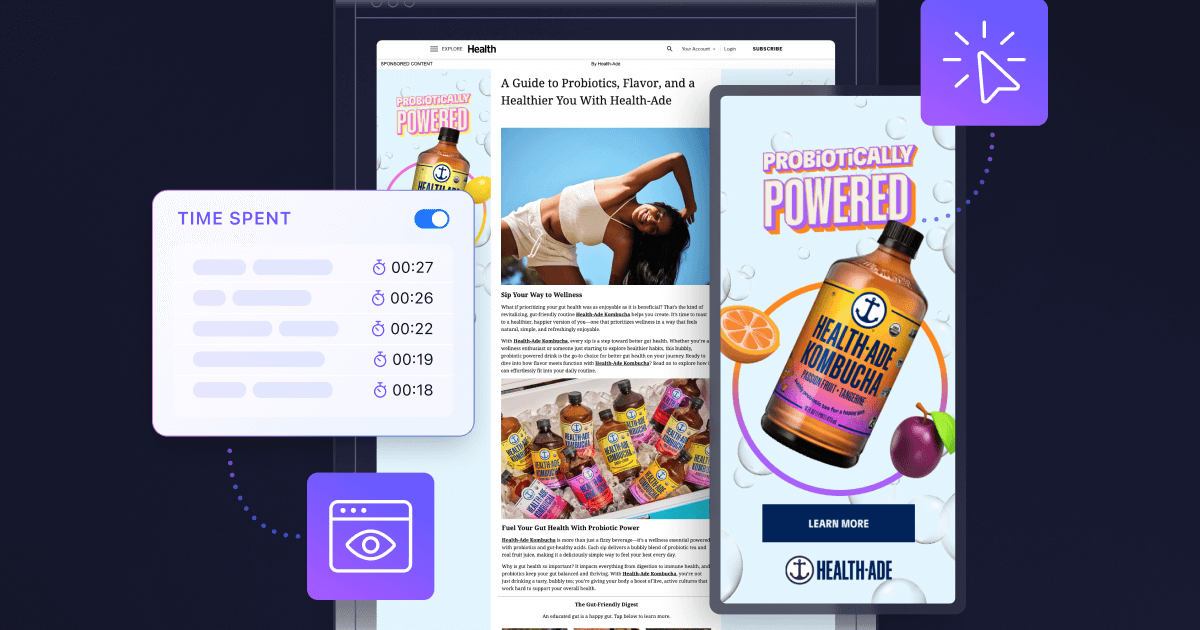What Type Of Media Is Native Advertising?
.png)
In the bustling world of online advertising, where users are continuously bombarded with overt promotions, native advertising has emerged as a subtle and more refined approach to reach audiences. But what exactly constitutes native advertising, and what types of media can be used to deliver it? In this post we delve into the various forms of media that can be employed for native advertising and provide examples of how they seamlessly blend with online content.
Types of Media in Native Advertising
Images
Display content can include images, banners, infographics, and any visual representations meant to capture the audience's attention. Brands often use display content to visually communicate their message, hoping to leave a lasting impression on viewers.
Example: A health blog might feature an infographic about the benefits of a particular superfood. This infographic, while informative, might be sponsored by a company selling that superfood.
Textual Content
This often refers to written materials like articles, listicles, stories, or other readable formats. Brands use textual content to educate readers, narrate stories, and subtly introduce their products or services.
Example: An article about home renovation on a lifestyle website might feature a native advertisement about a particular brand of paint. The advertisement would appear as a natural part of the article, maintaining the same tone and style as the rest of the content.
Video
Native video advertising integrates promotional video content within the regular video feed, making it appear like a regular video post. Video native advertising is popular for product launches, event promotions, and brand storytelling.
Example: On a social media platform like Facebook, a native video advertisement might appear in the news feed and autoplay just like any other video shared by friends. The content might showcase a new smartphone's features but will be produced in a way that it doesn't feel overtly promotional.
Interactive Content
Interactive native ads engage users by offering them an interactive experience, such as quizzes, polls, or even games. Brands use interactive content to engage users more deeply, making the promotional message more memorable.
Example: A travel website might host an interactive quiz titled "Find Your Next Vacation Destination." Upon completion, the quiz results could subtly recommend a travel package from a sponsoring company.
Recommendation Widgets
These are third-party widgets embedded on websites, usually at the end of articles, showcasing "recommended" articles or products. They're often powered by content discovery platforms. Brands leverage recommendation widgets to drive traffic to their content, hoping to capture the audience's attention post-engagement.
Example: After reading a health article on a blog, a user might see a widget showcasing "Other articles you might like," with some of these being sponsored content.
Podcasts and Audio
Native advertising in the audio realm typically involves sponsored content or brand mentions within podcasts or online radio segments. This could range from a host discussing a product or service to an entire episode sponsored by a brand. Brands use podcasts and audio native advertising to reach a captive audience, leveraging the trust listeners have in the podcast host.
Example: In a popular tech podcast, the host might spend a couple of minutes discussing the features of a new software tool, mentioning that the episode is sponsored by the software's company.
Social Media Stories
Stories are ephemeral content on platforms like Instagram, Snapchat, and Facebook. Native advertising in stories usually appears as a branded story interwoven among stories from friends and accounts a user follows. Brands utilize story-based native advertising for timely promotions, product launches, and to engage users in a more immersive and visual format.
Example: A user might be viewing stories on Instagram and come across a short video showcasing a new line of clothing from a fashion brand.
Branded Content and Partnerships
This involves collaborations between brands and content creators or publishers to create content that resonates with the audience while subtly promoting the brand. Brands leverage branded content partnerships to tap into the existing audience of popular creators or publishers, ensuring authentic engagement.
Example: A popular travel blogger might collaborate with a hotel chain to create a series of posts or videos about their stay at various locations, highlighting the amenities and experiences.
Chatbots and Messaging Integrations
With the rise of messenger platforms and chatbots, native advertising is evolving into interactive conversations. Brands can sponsor chatbot experiences or integrate promotions within messaging platforms. These are often used for personalized promotions, offering solutions based on user queries and interactions.
Example: A user might interact with a chatbot on a travel website, and during the conversation, the bot subtly recommends a sponsored hotel deal.
Augmented Reality (AR) and Virtual Reality (VR)
AR and VR provide immersive environments for users, and native advertising within these spaces can offer highly engaging experiences that meld organically with the virtual surroundings. Brands leverage AR and VR native advertising to create memorable and interactive brand experiences, capitalizing on the novelty and immersion these technologies offer.
Example: In an AR-based game, a user might encounter a virtual coffee shop where they can "buy" a coffee using credits. This coffee shop could be a subtle promotion for a real-world coffee brand.
The Art of Subtlety in Native Advertising
The power of native advertising lies in its subtlety. The idea is not to deceive the audience but to provide value in a format that feels natural and less intrusive. Brands must maintain transparency by appropriately labeling their native ads while also ensuring that the content is relevant and beneficial to the user.
Native advertising can be presented through a variety of media forms, each offering unique ways to engage with audiences. Whether it's through a well-crafted article, an engaging video, or an interactive quiz, the key to effective native advertising is ensuring that it offers genuine value while blending seamlessly with the platform's organic content.
See what's possible with Nativo. Fill out the form below to schedule a free demo with one of our dedicated experts.

.jpg)


